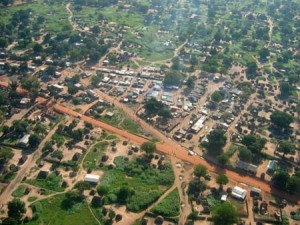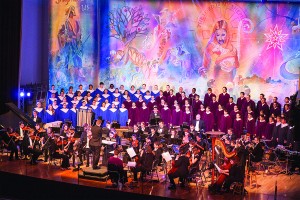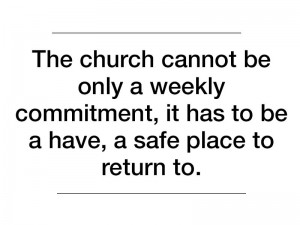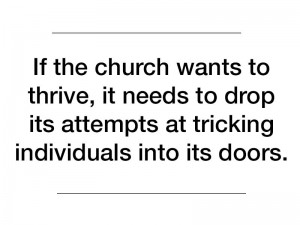 The Church has always been big on family. Many churches preach about how today’s society has lost the value of family. The divorce rate is thrown around and pastors have people raise their hands to see who actually eats dinner together. While this is a lovely sermon that I can’t disagree with, I am finding it increasingly hypocritical. Not because I find that Christians do not have whole, healthy families, but because the Church itself has ceased to be a family.
The Church has always been big on family. Many churches preach about how today’s society has lost the value of family. The divorce rate is thrown around and pastors have people raise their hands to see who actually eats dinner together. While this is a lovely sermon that I can’t disagree with, I am finding it increasingly hypocritical. Not because I find that Christians do not have whole, healthy families, but because the Church itself has ceased to be a family.
This issue never bothered me until a third grader at my home church came up to me and informed me he was angry he could not go to ‘his church’. When I told him that he was at his church, he explained that his church was the children’s church and that I had a separate church in ‘the big room’. This completely horrified me. He essentially viewed the children’s church as separate, and did not realize that he was in the same church family as his parents.
What does that teach children? What does that teach anyone? It can create, in the most toxic of environments, an intense self-centeredness and narrow-minded attitude. How are we supposed to grow and stretch if we are only interacting with our own age group or demographic? I don’t have an issue with a Bible study geared towards a demographic for that relation and encouragement to happen. I don’t have an issue with specialized groups. The main issue is that worship should include the entire congregation.
Church worship is meant to be done as a family. I find it discomforting that it is increasingly prevalent for churches to be split by age. It usually tends to look like this: infants go to the nursery, preschool/elementary aged children spend the ENTIRE church service in a classroom having “children’s church,” some churches put teens in a “youth service” and, even worse, there are churches having a separate church service for college aged students.
The o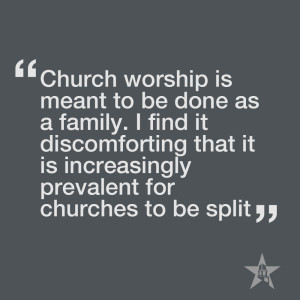 ne place where ages should mingle and find solidarity in Christ, where Christians engage with and learn from different demographics, where we learn to worship together whether or not we personally enjoy drum-kits or liturgy or gospel music, is gone. Families outside of church include the mixture of ages, the compromise of living with those of a different generation, so why shouldn’t the church have that too? Shouldn’t the church be a mirror of what God intended a family to be? We use the word family because it’s all-inclusive and signifies a personable and close relation, so why make church age exclusive?
ne place where ages should mingle and find solidarity in Christ, where Christians engage with and learn from different demographics, where we learn to worship together whether or not we personally enjoy drum-kits or liturgy or gospel music, is gone. Families outside of church include the mixture of ages, the compromise of living with those of a different generation, so why shouldn’t the church have that too? Shouldn’t the church be a mirror of what God intended a family to be? We use the word family because it’s all-inclusive and signifies a personable and close relation, so why make church age exclusive?
To give a solution of how I feel congregational worship should look, let me start with an example I have witnessed while at Houghton. One of the ministries that I have encountered the last few years is Sojourner’s Mennonite. While their style of worship is unusual and not meant for every worshipper, there is one thing that every church can take away from them: their focus on family. Children help pick out songs for worship, the older members might bring food to share or play an instrument, college aged congregants may lead worship. It’s communal. Church should be a place where all ages feel welcome and included. I think a church should have congregational worship that does not focus on an age group, but worship that clearly recognizes the diversity of ages represented and respects them. Worship that makes one look at what they can give instead of what they can take and, in many cases, that simply starts with blending age groups together.

